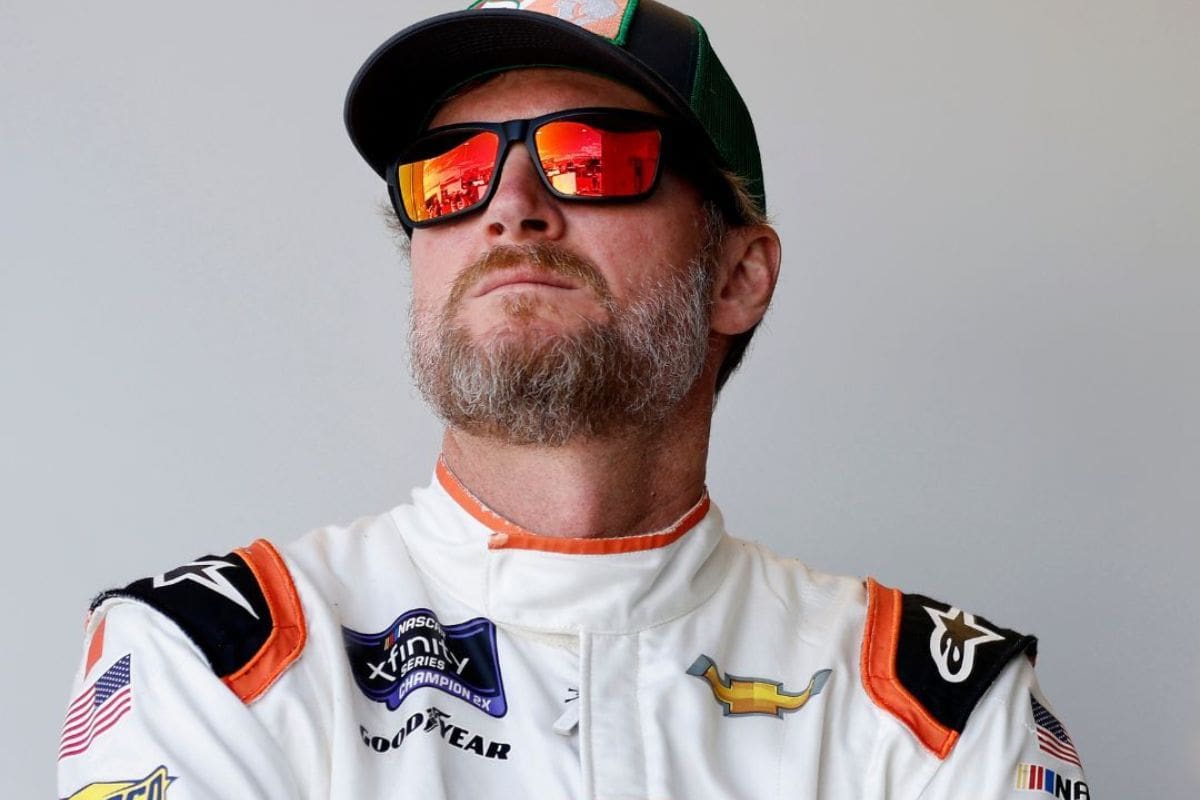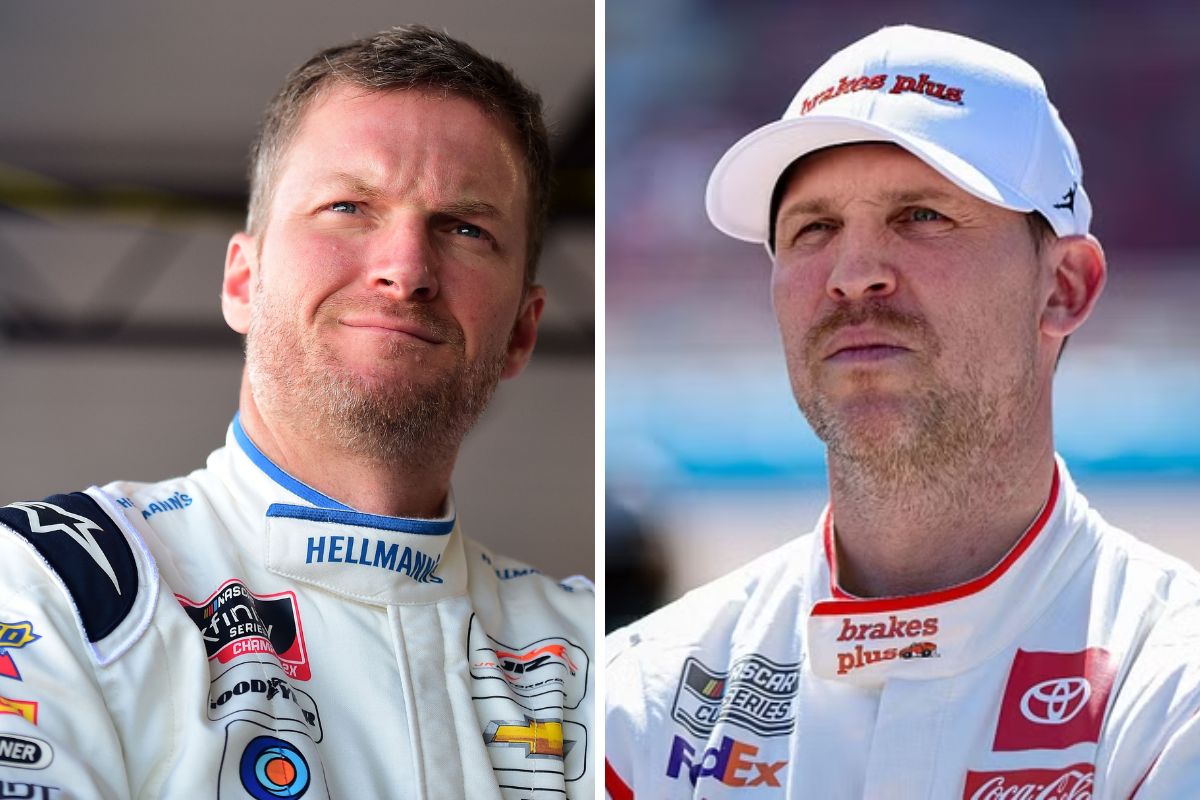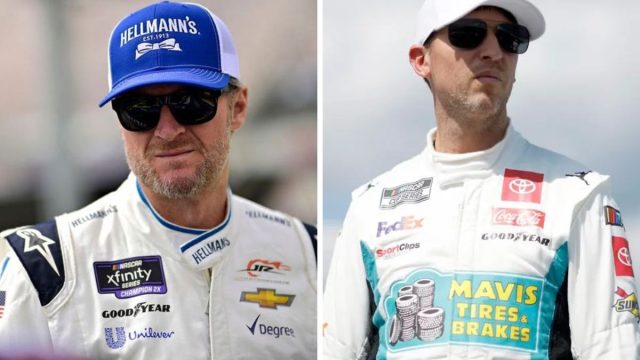Dale Jr. Joins Hamlin’s Pylon Protest: The recent alignment of Dale Earnhardt Jr. with Denny Hamlin in the protest against the removal of scoring pylons at Talladega Superspeedway marks a significant escalation in a debate that transcends mere race course aesthetics. This union spotlights the deeper implications on race strategy and spectator engagement, highlighting the pylons’ role not just as informational tools but as integral elements of NASCAR’s competitive fabric. With Earnhardt’s inclusion in the cause, the issue gains a broader resonance, questioning whether NASCAR is maintaining the right balance between heritage preservation and technological evolution.
Key Takeaways
- Dale Earnhardt Jr. supports Denny Hamlin in protesting the absence of scoring pylons at Talladega Superspeedway.
- The protest emphasizes the pylons’ role in strategic race decision-making and fan engagement.
- Earnhardt Jr. critiques the current scoring systems, advocating for better visibility and effectiveness.
- The debate highlights broader concerns over preserving NASCAR’s tradition versus adopting new technologies.
- Their joint stance has intensified discussions on the necessity and future of scoring pylons in NASCAR races.
Denny Hamlin and Others Protest Against Removal of Scoring Pylons
Leading the charge against the removal of scoring pylons, Denny Hamlin and several fellow NASCAR drivers have voiced significant concerns, highlighting the essential role these structures play in boosting race strategy and driver awareness. Hamlin, a seasoned racer, articulated that the immediate visual feedback provided by scoring pylons is indispensable during high-octane races. These pylons, often towering structures equipped with digital displays, serve not just as a tool for spectators but as a vital strategy asset for competitors.

The argument put forth by Hamlin centers on the real-time tactical adjustments that drivers make based on their and their competitors’ positions. Positional awareness is key in motorsport racing; understanding whether one is leading, falling behind, or in need of overtaking can dictate the aggressive tactics a driver chooses to employ. This is particularly critical in races where strategic pit stops and tire management play a significant role in the outcome.
“I think what created so many exciting times during qualifying was when the number would pop up on the scoring pylon. P1 for Dale Jr., whoever it was.”-Hamlin
Kyle Larson and Christopher Bell, who echo Hamlin’s sentiments, point out that the removal of such pylons could lead to a degradation in the quality of racing. According to them, without these pylons, drivers are left parsing through radio communications or waiting for updates from their teams, which can introduce delays and errors. The immediacy with which pylons convey standings is unmatched by any current in-cockpit technology.
Outcry Over Missing Pylons at Talladega Superspeedway
The recent absence of the scoring pylon at Talladega Superspeedway sparked considerable controversy among NASCAR enthusiasts, emphasizing a deep-seated respect for tradition in the sport. This incident not only highlighted the emotional attachments fans and participants share towards these historical elements but also highlighted the complex relationship between modernization and preservation within NASCAR’s evolving landscape.
Jeff Gluck and Jordan Bianchi’s analysis suggests that the removal was met with vociferous objection, not just for the loss of a physical structure but for what it represented—a tangible link to the storied past of NASCAR racing. The pylon, more than just a tool for displaying scores, served as a cultural artifact that connected generations of fans. Its absence was felt as a disconnection from a cherished history.
Dale Earnhardt Jr.’s Mixed Opinion on Scoring Pylons
Dale Earnhardt Jr., aligning partially with Denny Hamlin, recognized the importance of scoring pylons at different tracks, yet he voiced specific concerns about the readability and effectiveness of the one at Talladega Superspeedway. His critique highlights a detailed perspective on the utility and performance of informational systems in NASCAR races. Earnhardt Jr. aptly emphasizes a critical issue that could potentially impact race strategies and viewer experience.
“The one that’s in Texas, that type of pylon at that size of a race track at that location, is necessary…When you look at the one in Indianapolis and Texas…owned by Marcus Smith, he put an incredible pylon at North Wilkesboro Speedway.”
“In some instances, the pylon is a staple, almost like a historical monument-style vibe with it at certain race tracks.”-Dale jr.
The issue at Talladega’s tri-oval track revolves mainly around the legibility of the scoring pylon, which is vital for drivers and teams to make informed decisions in real-time. A poorly designed or positioned pylon not only hinders the strategic aspects of racing but also detracts from the spectator’s understanding and engagement.
“I remember, that one wasn’t very good, you couldn’t read it…The damn bulbs that lit the numbers up were so tiny…It was almost like…you ever had a calculator with batteries dying?… I won’t miss it.”
“You know, the ARCA race was always going on during the day…we were moving in and out of the garage area and infield…you look at that thing and go, ‘I can’t freaking read’…It was a pain in the a**”. -Dale jr.

Dale Earnhardt Jr.’s Comparison Between Flagmen and Pylons
Building on his criticism of the scoring pylons, Dale Earnhardt Jr. also highlighted the lasting significance of flagmen in racing, emphasizing their irreplaceable contribution to the sport’s atmosphere despite technological advancements. Earnhardt Jr.’s perspective brings to light a detailed debate concerning the evolution of race management tools and the preservation of racing culture. The flagman, with his vibrant flags, stands not just as a necessary component but as a symbol deeply rooted in the heritage of motorsport.
Earnhardt Jr. articulates a vision where tradition and technology coexist, suggesting that the human element provided by flagmen offers a unique connection to the spectators, creating an engaging and dynamic race experience. This connection, he argues, cannot be replicated by the static, albeit informative, presence of scoring pylons. The flagman’s role transcends mere operational functionality; it embodies the drama and passion of racing, elements that are at the heart of spectator sports.
“I think at certain tracks it’s absolutely part of the atmosphere…I would say, compare this to the flagman…NASCAR has multiple flagmen on payroll. They could absolutely have a giant block at the flag stand that was an LED light lit up in whatever color…and take that flag man out of that stand entirely. But that flag man is so critical to the DNA of motorsport, NASCAR’s not going to do that…That’s the way I kind of feel about the pylon.”-dale jr.
The Future of Scoring Pylons in NASCAR
As NASCAR continues to integrate advanced technologies, the role and relevance of traditional scoring pylons at race tracks are being critically reassessed. The towering structures, once crucial for informing spectators of race standings in real-time, now face examine over their necessity in the modern digital age. With advancements in digital displays, mobile apps, and augmented reality, the information once exclusively held by pylons is now widely available, potentially rendering these iconic structures as mere nostalgic artifacts rather than functional necessities.
The push led by figures like Dale Earnhardt Jr. and Denny Hamlin against the pylons isn’t just a nod to modernity but also sparks a broader debate about how NASCAR interacts with its audience. The argument isn’t merely about the visibility or aesthetics of the pylons but encompasses a larger discussion on how technology should be utilized to enrich fan engagement and experience. As real-time data sharing becomes seamless, the traditional methods of information dissemination are overshadowed by more interactive and immersive technologies.
However, the decision to phase out pylons cannot solely depend on technological redundancy. It must consider the cultural significance and the fan sentiment attached to these structures. Pylons have been more than just scoreboards; they are part of the spectacle and tradition of NASCAR races, contributing to the unique atmosphere at the tracks.

News in Brief: Dale Jr. Joins Hamlin’s Pylon Protest
The protest led by Denny Hamlin and supported by Dale Earnhardt Jr. against the removal of scoring pylons at Talladega Superspeedway highlights a crucial tension in NASCAR between maintaining traditional elements and embracing technological progress.
This movement not only emphasizes the significance of such structures in enhancing spectator understanding and experience but also sparks a broader discussion about the preservation of racing heritage.
As NASCAR evolves, the resolution of this debate will be essential in shaping the future interaction between historical practices and modern innovations in the sports.
ALSO READ: Dale Jr Slams Hamlin’s NASCAR Idea: “You’re Pissing Me Off”
